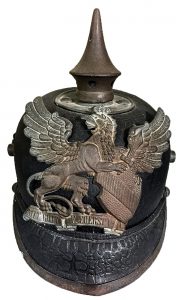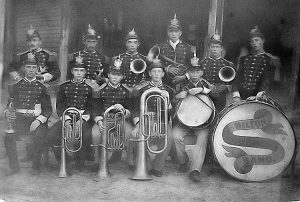One of the more curious artifacts in the Milton Historical Society’s collection stored in the museum attic is this Pickelhaube (spiked) helmet, worn by the members of the Milton cornet band in the 1890’s. Anyone familiar with photographs of German infantry from the early years of World War I or of its police and fire brigades from the 19th century will recognize this helmet style with its characteristic spike on top. While we usually associate the Pickelhaube with Imperial Germany, it was originally designed for the Prussian military in 1842, and later adopted by other pre-unification German principalities. After the reunification of Germany under Prussian leadership in 1871, the Pickelhaube became the standard helmet design for German soldiers, policemen, and firemen. The helmet design found favor with other non-German nations such as Portugal, Norway, Sweden and Russia, and especially in South America, where German military missions trained the local armed forces in Bolivia, Colombia, Chile, Ecuador, Mexico, and Venezuela.


The Pickelhaube owned by MHS is in fairly good condition, and the motto on the front can easily be read: “Mit Gott F. Fuerst U. V.” (“Mit Gott für Fuerst und Vaterland”), which translates to “With God for Sovereign and Fatherland.” Among the variations of this motto that appeared on other Pickelhaubes were “With God for King and Country.” This begs the question, why on earth was an overtly German helmet adopted by the Milton cornet band? The fact of the matter is that the adoption of this design by Milton musicians reflects the great influence of the large number of German immigrants to the U. S. in the 19th century. Their influence on American cultural institutions, food, education, and farming (to name just a few items) was enormous. The German immigrants brought the accordion and the tuba with them, and popularized the brass band as a musical idiom throughout the U. S. In Texas, where there was a concentration of German immigrants, the accordion was introduced to descendants of the original Mexican settlers as well as to their relatives south of the border, and became a featured instrument in an amalgamation of styles collectively call “Tejano.” Several AM radio stations and at least one FM station in Delaware play this type of music, which finds a ready audience among the Latino population of the First State.
Given the profound influence of Germans on American culture in the 19th century and the tremendous respect accorded to German civilization prior to the decade before World War I, the presence of the “Pickelhaube in the Attic” is not surprising at all.

I have just learned that this helmet belonged to Dr. Robert B. Hopkins, who had bought all of the uniforms for the band. The helmet was donated to MHS by his grandson Robert Mark Hopkins, who says he used to play with it as a child.
In addition, the metal plate on the front (the chimera) is associated only with the former German principality of Baden; it does not appear on most other examples of Pickelhauben that I’ve seen. However, the motto is fully spelled out on examples of Baden Pickelhauben. What the significance of Baden might be in connection with a brass band has yet to be determined.
Good evening
I don’t see any resemblance between these spiked helmets. I’m not expert about U.S. pickelhauben but surely the first, that opened the page is a true Baden model 1915. It missed the chin-strap and the side-cockades, as quite usual. Possibly a war-trophy from a U.S. WW1 veteran?
Best regards
Marcello Ravaioli
Marcello,
We don’t know exactly where this helmet was made, other than the fact that it was acquired for the use of a small town band. It was modeled after the Baden fashion, as it appears to be, but it is definitely NOT a war trophy. The second picture, of the band in uniform, shows the musicians all wearing it, and that photograph dates from before 1900. The gentleman who donated the helmet to our museum is the still-living grandson of the band leader who bought the helmets and uniforms. By the time of the sinking of the Lusitania in 1915, Americans were rapidly became hostile to all things German. One of the first things to be discarded would have been the German-style helmets and uniforms, but in any case the Milton Firemen Band had different uniforms by then.